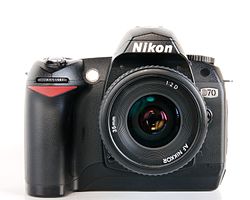 | |
| Overview | |
|---|---|
| Maker | Nikon |
| Type | Digital single-lens reflex camera |
| Lens | |
| Lens mount | Nikon F-mount |
| Lens | Interchangeable, Nikon F-mount |
| Sensor/medium | |
| Sensor | 6.1 megapixel 23.7 mm × 15.6 mm Nikon DX format RGB CCD sensor, 1.5 × FOV crop |
| Maximum resolution | 3,008 × 2,000 (6.01 million) |
| Film speed | 200 to 1600 (ISO equivalent) in steps of 1/3 EV manually or Auto ISO |
| Recording medium | CompactFlash (Type I or Type II) or Microdrive |
| Focusing | |
| Focus modes | Single Area AF, Dynamic Area AF, Closest Subject Priority Dynamic Area AF |
| Focus areas | Can be selected from 5 focus areas |
| Exposure/metering | |
| Exposure modes | Digital Vari-Program (Auto, Portrait, Landscape, Close up, Sports, Night landscape, Night portrait), Programmed Auto [P] with flexible program; Shutter Priority Auto [S]; Aperture Priority Auto [A]; Manual [M] |
| Exposure metering | 1,005 segment color meter, EV 0 to 20 (3D Color Matrix or center-weighted metering); EV 2 to 20 (spot metering) |
| Metering modes | Matrix, Center-weighted, Spot |
| Shutter | |
| Shutter | Combined mechanical and CCD electronic shutter |
| Shutter speed range | 30 s to 1/8000 s in steps of 1/3 or 1/2 EV, bulb |
| Continuous shooting | 3 frame/s up to 144 frames (JPEG/RAW) |
| Viewfinder | |
| Viewfinder | Pentamirror type, 0.75× magnification, 95% coverage |
| General | |
| LCD screen | 1.8 in or 46 mm (D70), 2.0 in or 51 mm (D70s), 130,000 pixel TFT |
| Battery | Nikon EN-EL3e Lithium-Ion battery |
| Weight | no battery 595 g (21.0 oz), inc. batt 679 g (1.497 lb) |
| Made in | |
The Nikon D70 is a digital single-lens reflex camera, introduced at the 2004 PMA Annual Convention and Trade Show, as Nikon's first consumer-level digital SLR, and a competitor to the Canon EOS 300D. [2] It was often sold in a "kit package" with the Nikon 18-70mm AF-S lens. The Nikon D70 was succeeded initially by the Nikon D70s and eventually by the Nikon D80 and Nikon D90, announced on August 9, 2006 and August 27, 2008 respectively. The Nikon D70 is the first DSLR camera built by Nikon's factory in Thailand. It debuted at a price of US$999.


